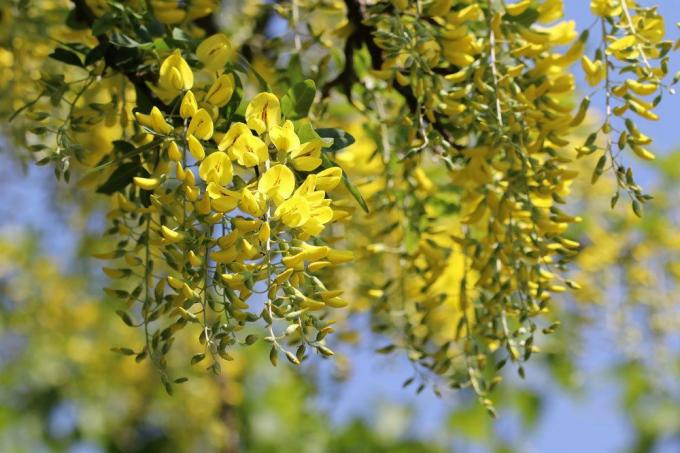
table of contents
- Toxicity
- Cytisine
- Secondary substances
- Ammodendrin
- Effect on people
- Effect on animals
the Laburnum (bot. Laburnum) with their characteristic golden yellow flowers are among the most popular flowering trees in the temperate latitudes. It is precisely these flowers and their seeds that encourage children in particular to touch or even consume them. Many people wonder whether Laburnum is one of the domestic poisonous plants and whether just one touch is enough to poison yourself.
Toxicity
Is laburnum poisonous?
The question of whether the species of the genus Laburnum are poisonous can be answered with a clear yes. Laburnum species are among the most poisonous plants in Germany, Central and Southern Europe and represent a great danger to humans and animals. Without exception, all parts of the plant are poisonous. The reason for this is the appearance of the flowers and fruits. While the flowers stand out because of their bright yellow, the legumes are similar to conventional beans, which can be fatal. However, the differences from beans are clear, just not for children.
- Shell less strongly colored
- Fruits in the shell are very dark in color

They pose the greatest danger, especially when they are still closed, as they look so confusingly similar to haricot beans. The toxicity of the plant comes from the ingredients that are found in Laburnum in a very concentrated manner in terms of their toxic effect:
Cytisine
Cystine is a toxin that belongs to the group of quinolizidine alkaloids, of which the laburnum contains a large amount. These alkaloids are nitrogen-based, and the poison itself has the following properties.
- toxic effect
- Intoxication is not triggered
- interacts with the brain like nicotine, so it has an effect on it immediately after ingestion
- is found in an amount of 1 percent in the seeds
- also contained in other parts of the plant such as the leaves and flowers
- resembles the poison of poison dart frogs in its effect
A special feature of the toxin is the seasonal amount. Depending on the nature of the seasons and the condition of the plant, the more or less cytisine is present in the parts of the plant. But even if the toxin content should be much less in a season, it does not mean that these can be consumed. Above all, there is great danger when the seeds are ripe.
Secondary substances
The laburnum species also contain other substances such as N-methylcytisine and laburnine, which have different effects on the body. The laburnine, for example, always occurs together with cytisine.
Ammodendrin
This additional toxin can only be found in the Alpine laburnum (bot. Laburnum alpinum) and has a damaging effect on the central nervous system.
Together, these substances create a cocktail of dangerous properties that can affect not only children and numerous animals.
Tip: The poison cytisine is so dangerous that planting laburnum and other plants such as gorse (bot. Genista germanica) and honey trees (bot. Styphnolobium japonicum) in the vicinity of kindergartens, elementary schools and playgrounds is expressly prohibited. Poisoning by the plant usually happens through specimens in one's own garden, on public properties or those that have overgrown.

Effect on people
A great advantage of Laburnum is the fact that it cannot be poisoned when touched. The toxins are present in sufficient numbers in all parts of the plant, but they cannot be released to the skin. Only when the plant is chewed can the substances work. Rubbing the plant also has no effect and for this reason the laburnum species are actually safe to handle. However, the consumption and, above all, the swallowing of the plant parts, especially the seeds, must be avoided. The following symptoms are the same in children and adults.
- Racing heart
- increased salivation
- Sweats
- Irritation of the mucous membranes for up to two hours
- Vomit
- Blood in the vomit
- Tremble
- nausea
- Circulatory failure
- Respiratory paralysis
- cramps
- Death if swallowed
The laburnum is immediately toxic when it comes into contact with saliva, as well as when chewing, but here the symptoms are still on the "safe side". If the seeds or other parts are swallowed, death can occur within a short period of time, usually through respiratory failure. The first symptoms of poisoning in children appear from one semen, in adults only from three.
The lethal dose is:
- Children: 15 – 20
- Adult: from 23
There are twelve of the leaves that cause symptoms of intoxication. The golden rain is characterized by a feeling of mental excitement at the beginning, which can give way after 15 minutes and give way to discomfort. If your child has eaten parts of the golden rain plant, you must immediately go to a children's clinic or hospital. Be sure to drink water during transport.
Effect on animals
For animals, especially mammals and birds, the laburnum is poisonous in every essence. Dogs accidentally eat the beans and appear uncomfortable, convulsive and vomit. The lethal dose is two to seven grams of seeds per kilogram. Dachshunds, for example, are more endangered than St. Bernard dogs. Dogs have the advantage that they usually vomit immediately and thus the poison cannot get to the brain. Cats do not have this protection and an average of two to four grams of semen per kilogram is sufficient to be extremely toxic. Horses, on the other hand, can consume a whopping 250 grams of the seeds, but the effects are also deadly.

sources
- http://www.gizbonn.de/124.0.html
- https://de.wikipedia.org/wiki/Goldregen_(Pflanze)#Giftigkeit
- https://de.wikipedia.org/wiki/Gemeiner_Goldregen#Giftigkeit



